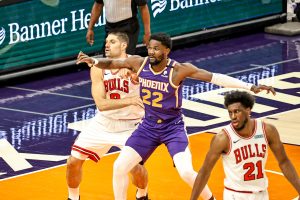- Slug: Sports-NBA Analytics, 900 words.
- File photo available
By Alex Amado
Cronkite News
PHOENIX – In mid-February, even though the Phoenix Suns had the best record in the NBA, they only had the third-best chance to win the NBA Finals, according to FiveThirtyEight’s popular analytical model.
The favorite? The Boston Celtics at 21%, even though they sported a 34-25 record and 10 teams in the league boasted more wins, including the NBA-leading Suns at 47-10.
As the Golden State Warriors take a 3-2 lead into Boston tonight for Game 6, the models’ “opinions” have shifted, although a healthy respect for the Celtics remain.
Although the Warriors came into the final series with a roster featuring 123 games of combined NBA Finals experience and the Celtics roster came in with zero, at least two well-regarded number-crunchers had Boston as a heavy favorite to win it all before the start of this series: FiveThirtyEight and ESPN BPI (Basketball Power Index)
The FiveThirtyEight model gave the Celtics an 80% chance to win the series, while ESPN BPI gave them an 86% chance.
When the Warriors took a 3-2 series lead, it was the first time Golden State was favored to win the title by the models, and it’s not by that much considering it only needs one more win and will have home court advantage if it comes to Game 7.
Entering Game 6, FiveThirtyEight has the Warriors favored by 63 percent, while ESPN BPI has their odds at only 59.6 percent to win the series. It’s a sharp contrast to the opinion of Las Vegas oddsmakers, who have Golden State at a convincing -400, which suggets an 80% probability to win the series, although how fans are expected to bet also weighs into the equation.
So, why have analytics been so high on the Boston Celtics?
Putting aside context and looking directly at the numbers, the Celtics were the better team during the regular season.
“The general idea is that the FiveThirtyEight NBA model is based on player ratings, using a system called RAPTOR,” FiveThirtyEight Sports Editor Sara Ziegler told Cronkite News. “The rotation players for the Celtics each rate very highly in RAPTOR, while many of the Warriors’ regulars rate lower.”
Ziegler added that “the focus on player ratings means that the projections don’t really consider team wins and losses. Wins and losses still matter, of course, but our model’s belief is that the player ratings are better indicators of how a team ultimately will do.”
Their model has been high on the Celtics since their midseason turnaround. At the time, many people considered that ridiculous, but here we are, with the Celtics in the Finals.
“During the regular season, Boston had a much better point differential than Golden State on both a per-game (+7.3 versus +5.5) and per-100-possession (+7.5 versus +5.6) basis,” FiveThirtyEight’s Neil Payne wrote recently. “While the Warriors won two more games than the Celtics, that happened because Boston undershot its Pythagorean record by eight games – making it the unluckiest team in the league by that measure. And none of this was simply an artifact of schedule strength: According to Elo ratings, Golden State’s opponents were just 0.3 points per game better than Boston’s in the regular season.”
Got that?
Analytics is not just for observers, but they are part of all NBA front offices as well. Number crunching can help determine matchups as well as how much a player can rest.
Not everyone has fully embraced the philosophy of analytics.
“My issue with analytics is not the people that’s doing it or the numbers itself, it’s the fact that it intrudes upon the game, and now players are robotic,” Suns analyst and former NBA sharp-shooter Eddie Johnson told Forbes. “That’s not the game I played.”
As for ESPN BPI’s model, it is a measure of team strength developed by the ESPN Analytics team. BPI is meant to be the best predictor of a team’s performance for the rest of the season and represents how many points above or below average a team is. BPI accounts for game-by-game efficiency, strength of schedule, pace, days of rest, game location and preseason expectations.
As for Vegas odds, Josh Appelbaum of Action Network wrote that “in order to come up with the odds on a given game or matchup, oddsmakers use a complex set of mathematical models, formulas and computer algorithms. They also come up with power rankings based on key statistical categories, including strength of schedule and margin of victory.”
But, unlike the analytical models, Vegas odds allow the general public to influence their line based on how many people are betting on a certain outcome.
Eighty-seven percent of the money wagered at PointsBet before Game 1 was on the Warriors to win the best-of-seven series.
The general public being heavily in on the Warriors before the season was a driving factor as to why they were a slight favorite to win the series across sports books before the season started.
The experience of the Warriors, paired with the impressive performance of Stephen Curry and the rest of the team in the postseason, has elevated the perception of the team and caused most to expect the Warriors to run circles around the inexperienced Celtics team.
Of course, after the Celtics’ blazing comeback in Game 1 to take home court advantage, the public perception quickly shifted to a more even series, and the odds reflected that.
One thing that didn’t change much though: The analytical models believe in the Celitcs more than most humans.
